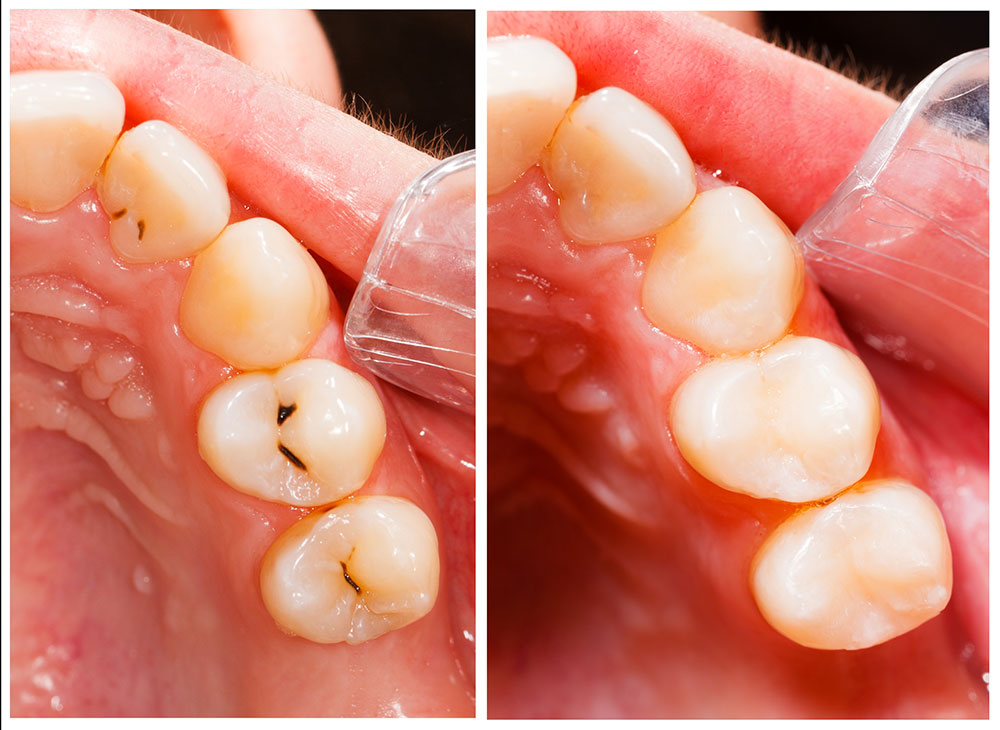Have you ever put off having a dental procedure done because you were scared?
If so, you are not alone. Many people avoid getting dental work done because they have a fear of the unknown.
No one wants cavities when they visit the dentist, so it is important to practice good oral hygiene at home and get regular dental check-ups to catch any problems early before they turn into a dental filling.
After all, good oral hygiene will reduce the risk of cavities and eliminate the need for a dental filling. Do not put off your dental check-ups. Good oral hygiene is related to overall good health.
Visit a Sunrise Dental office today to keep your mouth in tip-top shape without any cavities or fillings.
If it has been determined by your dental professional that a filling is needed to repair a cavity there are a variety of different materials that can be used for filling teeth. The two most common are amalgam fillings or silver or mercury fillings, made up of silver, tin, copper, zinc, and mercury, and composite resin fillings known as white fillings, tooth-colored fillings, and direct veneers. Both are viable options, but only a dental professional can determine what the best option for your filling is.
The average life of a filling is about 12 years. It is important to visit your dentist regularly so that your fillings can be examined. Between dental check-ups, it is also important to maintain good oral hygiene to prevent decay from occurring under the filling.
If you have many fillings or very large fillings, your dentist may prescribe a fluoride gel you can use at home. You can also use rinses that lower the acid level of your mouth. A lower acid level reduces decay-causing bacteria. This can lead to fewer cavities and dental fillings in the future.
Call a Sunrise Dental office today to schedule your check-up. Don’t let something simple turn into something more serious. The friendly staff at Sunrise Dental can help you with any questions you have concerning dental fillings.
We have many locations in the Bellevue, SeaTac, Seattle, Downtown Seattle, Snohomish, Bothell, Mill Creek, Lynnwood, and Olympia areas with convenient hours to meet your needs.

Please Call Us At: +1 (855) 467-8674
- Brush your teeth at least once per day, but two times is better. Brush in the morning when you awake, and at night before you go to sleep. When possible, after meals, rinse your mouth out with water.
- Floss once per day, usually towards the end of the day, to remove any particles and bacteria from between teeth.
- Eat healthy balanced meals, and avoid sugary snacks or sticky foods that can stick to teeth.
- Do not eat late night meals, and if you do, please make sure and brush before you go to bed.
- Do not smoke or use tobacco products. They can weaken and stain teeth permanently.
Dental fillings
Visit a Sunrise Dental office today to keep your mouth in tip-top shape without any cavities or fillings. If your dental professional has determined that a filling is necessary, various materials can be utilized for the procedure. The two most common options are amalgam fillings (silver) and composite resin fillings (tooth-colored). The lifespan of a filling typically averages around 12 years, subject to individual lifestyle and genetic factors. It is important to visit your dentist regularly so that your fillings can be examined.
What is a dental filling, and what is its purpose?
A dental filling is a routine procedure for the treatment of cavities. It includes removing decay, cleaning, and filling the tooth with suitable material. This swift solution restores tooth function and prevents further decay, promoting overall oral health.
What are the primary types of dental fillings?
Dental filling types:
- Amalgam: Cost-effective, silver in color.
- Composite: Tooth-colored, versatile.
- Ceramic: Stain-resistant, durable, tooth-colored.
- Gold: Durable, noticeable gold color.
Choice depends on factors like location, decay, aesthetics, and budget.
Best Dentists in Washington & Oregon
What are the steps involved in getting a dental filling?
Getting a dental filling involves:
- Diagnosis: Dentist checks the tooth and uses X-rays for decay assessment.
- Anesthesia: Local anesthesia numbs the tooth and surrounding area.
- Decay Removal: Dentist removes decay, leaving a clean cavity.
- Tooth Preparation: Cavity shaped for proper filling adherence.
- Filling Application: Chosen material is applied and shaped.
- Curing (if applicable): For some fillings, like composite resin, a curing light may be used.
- Shaping and Polishing: Dentist shapes and polishes the filling.
- Final Check: Ensures proper positioning and bite alignment.
- Post-Treatment Instructions: Patients get care instructions, including potential sensitivity and oral hygiene practices.
The process is usually done in one visit, with regular checkups recommended for monitoring.
What are the signs and symptoms of tooth decay that might require a filling?
Signs of tooth decay needing a filling:
- Toothache
- Sensitivity
- Visible Holes or Pits
- Pain When Eating or Drinking
- Bad Breath
- Visible Stains or Discoloration
- Swollen or Bleeding Gums
- Painful Chewing
- Cracks or Fractures

How long does a dental filling last?
Dental fillings, regardless of material, typically last 5 to 15 years. Lifespan varies based on factors like filling type, size, location, oral hygiene, and individual differences. Regular checkups and good oral care habits contribute to filling longevity.
What is the typical recovery process after getting a dental filling?
After a dental filling, temporary numbness may occur if anesthesia was used. Mild discomfort or sensitivity in the treated tooth might last a day or two, typically manageable with over-the-counter pain relievers. Resume normal activities and follow your dentist’s care instructions. If concerns persist, contact your dentist for guidance.
